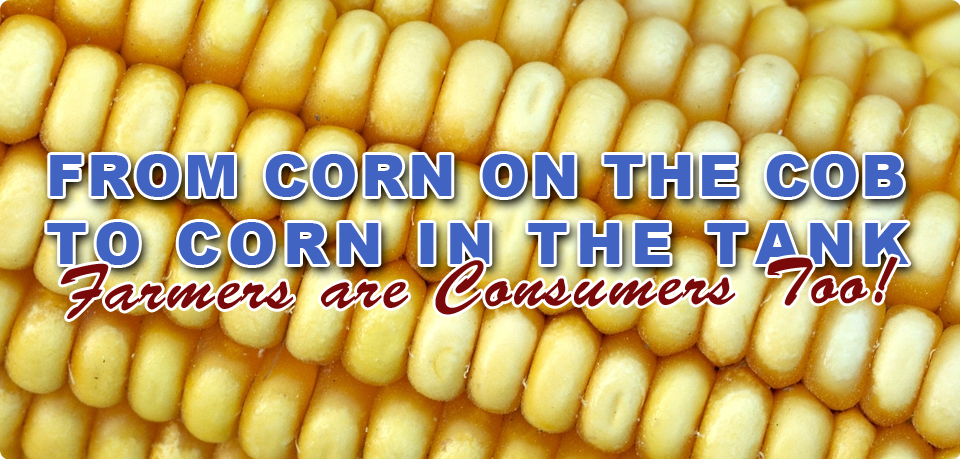Sometimes I wonder if non-farming consumers ever ask themselves how farmers feel about the price of food.
Farmers have to eat too!
Even though I’m a farmer, I am also affected at the grocery store when events such as the largest drought in the last fifty years drives corn prices to record highs. You don’t have to be much of a food label reader to know that corn finds its way into more than 2500 products on grocery store shelves. Having said that, food corn only represents 1% of the annual corn crop. The corn planted in 2012 represents the largest it’s been in the U.S. since 1937. One might assume that the one percent grown for human consumption may have benefited, depending on local water reserves, from irrigation and therefore will not see higher prices this year. According to industry experts, the value of the corn in both processed foods and non-food products is usually not large enough for the current corn price spike to have much impact on what the consumer pays at the checkout.
So, if the impact is small, why is the forecast for food prices to rise 4.5 per cent?
Regardless of individual items, the USDA projects overall food prices in the U.S. will rise three to four per cent in 2013. That’s more than the inflation rate but food prices have been running ahead of inflation for the last few years. The Wall Street Journal calculates that the impact of the drought will be “not that much,” or $32.76 for the year for the average U.S. consumer. Sylvain Charlebois, the project lead of the University of Guelph’s Food Retail Price Index, told CBC News that he does not expect the U.S. drought to have a significant impact on food prices in Canada. He forecasts food prices will increase by no more than 4.5 per cent in 2013, and only a fraction of that can be attributable to the drought.
Farmers Grow Corn. Farmers Buy Corn.
Recently, Statistics Canada released its latest crop production forecast. In contrast to what’s happening in the U.S., corn production in Canada is expected to increase 9.5 per cent from 2011. Nevertheless, the U.S. situation will have quite an impact on Canadian agriculture. Because nearly 43 per cent of U.S. corn goes to feed cows, pigs, chickens and even farmed fish, that is where the price increase is likely to be felt most. In Ontario, which grows about three-quarters of Canada’s corn, 50-55 per cent of the crop is used as animal feed.
About 12 per cent of U.S. corn gets exported and Canada is a big buyer. Last year, another 10 per cent of U.S. corn went into “other products,” while the remaining seven per cent was surplus.
Data shows that “Canada is by far the top buyer” for the other-products category which includes corn flour, starch, malt and worked grains.
First Increases will be in dairy and eggs
Dairy and egg prices should be the first to see an increase from the higher input costs. Beef and pork prices are actually forecast to drop initially. That’s because producers are expected to send some animals to market earlier than they would have otherwise, to reduce costs. In the short term, the extra supply will put downward pressure on meat prices and then smaller herds will mean less supply.
Corn in the Tank
After animal feed, the next largest share of U.S. corn ends ups as ethanol, which gets blended into the gasoline sold at the pumps. To encourage energy efficiency and renewable fuels, governments have mandated a minimum amount of renewable fuels being blended with gasoline. These laws have led to a progressively larger share of the corn harvest ending up as fuel. In Canada the federal government has set the average minimum content for renewable fuels at 5 per cent. In Saskatchewan, the mandate is 7.5 per cent; it is 8.5 per cent in Manitoba. The U.S. now has a 10-per-cent mandate for the amount of ethanol that has to be added to gasoline.
In the U.S., the National Corn Growers Association says 38 per cent of the country’s corn crop is destined for ethanol. But since those same cobs get made into both ethanol and animal feed, in the form of distillers’ grains, they do the math to end up with 29 per cent of the corn crop getting used for ethanol, and add nine points to what’s used for animal feed. In Canada, about 30 per cent of the corn crop is grown for ethanol, or about 20 per cent, after accounting for distillers’ grains.
When it comes to the price of ethanol, government subsidies and other factors that mean the end cost is not a simple equation based on input costs. Ethanol futures prices are up about 19 per cent since the start of the year. Corn prices, on the other hand, fell through the first half of the year but have spiked sharply since then, resulting in a price increase for corn of about 35 per cent so far this year. It is nearly twice that for ethanol. A surplus of ethanol has probably helped to keep its prices low and, with ethanol prices still below those of gasoline, analysts expect the increase in corn prices for consumers buying blended gas at the pump will be insignificant.
The Bullvine Bottom Line
When all is said and done, a bad crop year has wide-ranging ripples that can hit the farmer at multiple touch points. The farmer feels the negative effects twice at the farm, as a corn producer and corn consumer, and again as the consumer at the checkout. And so perhaps the original question needs to be changed, “Why don’t non-farming consumers recognize that farmers are consumers too?”
[related-posts-thumbnails]

















Leave a Reply
You must be logged in to post a comment.